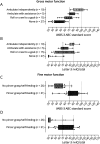Nonverbal Cognitive Skills in Children With Aicardi Goutières Syndrome
- PMID: 38857477
- PMCID: PMC11226315
- DOI: 10.1212/WNL.0000000000209541
Nonverbal Cognitive Skills in Children With Aicardi Goutières Syndrome
Abstract
Background and objectives: Aicardi Goutières syndrome (AGS) is type I interferonopathy characterized by severe neurologic impairment. Although many children with AGS demonstrate motor and expressive language deficits, the magnitude of receptive language impairment is uncharacterized. We sought to characterize cognitive function in AGS-affected children using assessment tools with reduced dependence on motor abilities and compare cognitive testing outcomes with overall severity and parental assessment of adaptive behavior.
Methods: We performed a cross-sectional study. Children were recruited as part of the Myelin Disorders Biorepository Project at the Children's Hospital of Philadelphia. We included individuals with a confirmed diagnosis of AGS. We administered the Leiter International Performance Scale, third edition (Leiter-3), and the Vineland Adaptive Behavior Scale, third edition (VABS-3), in the context of research encounters. Motor skills were categorized by AGS Severity Scale mobility levels. Descriptive statistics and Spearman's rank correlation were used to compare assessments. Mann-Whitney and Kruskal-Wallis tests with correction with Dunn's multiple comparison test were used to compare test performance between mobility groups.
Results: Cognitive and adaptive behavior performance was captured in 57 children. The mean age at encounters was 8.51 (SD 5.15) years. The median (IQR) Leiter-3 score was 51 (interquartile range [IQR] 60), with administration failure in 20 of 57 (35%) individuals. On the VABS-3, the Motor Domain (median 29, IQR 36.25) was more impacted than the Communication (median 50, IQR 52), Daily Living Skills (median 52, IQR 31), and Socialization (median 54, IQR 40) Domains (p < 0.0001). The AGS Scale correlated with VABS-3 (r = 0.86, p < 0.0001) and Leiter-3 (r = 0.87, p < 0.0001). There was correlation between VABS-3 Domains and Leiter-3 (r-range 0.83-0.97). Gross motor and fine motor categories, respectively, correlated with VABS-3 (H = 39.37, p < 0.0001; U = 63, p < 0.0001) and Leiter-3 (H = 40.43, p < 0.0001; U = 66, p < 0.0001). Within each gross motor and fine motor category of the AGS Scale, a subset of children scored within normal IQ range.
Discussion: Parental assessment of function by the VABS-3 correlated with directly assessed performance measures. Our data underscore the potential value of VABS-3 and Leiter-3 as tools to assess psychometric function in AGS. With a deeper understanding of our patients' abilities, we can better guide clinicians and families to provide appropriate support and personalized interventions to empower children with leukodystrophies to maximize their communication and educational potential.
Conflict of interest statement
F. Gavazzi, Y. Vaia, S. Woidill, B. Formanowski, I. Peixoto de Barcelos, A. Sevagamoorthy, N.B. Modesti, L. Charlton, S.V. Cusack, A. Vincent, R. D'Aiello, A. Jawad, J. Galli, C. Varesio, E. Fazzi, and S. Orcesi report no disclosures relevant to the manuscript. A.M. Glanzman is a consultant for Biogen, and receives royalties from licensing of the CHOP INTEND. S. Lorch, S.B. DeMauro, D. Guez-Barber, and A. Waldman report no disclosures relevant to the manuscript. A. Vanderver receives grant and in-kind support for research from Eli Lilly, Sana, Boehringer Ingelheim, Affynia, Sanofi, Synaptix Bio, Gilead, Takeda, Illumina, Biogen, Homology, Ionis, Passage Bio, Orchard Therapeutics. She serves on the scientific advisory boards of the European Leukodystrophy Association and the United Leukodystrophy Foundation, as well as in an unpaid capacity for Takeda, Ionis, Biogen, and Illumina. L.A. Adang receives research funds from and is a consultant for Takeda, Biogen, and Orchard Therapeutics. The AGS scale is copyrighted by the Children's Hospital of Philadelphia. Go to
Figures





References
MeSH terms
Supplementary concepts
Grants and funding
LinkOut - more resources
Full Text Sources
Medical
